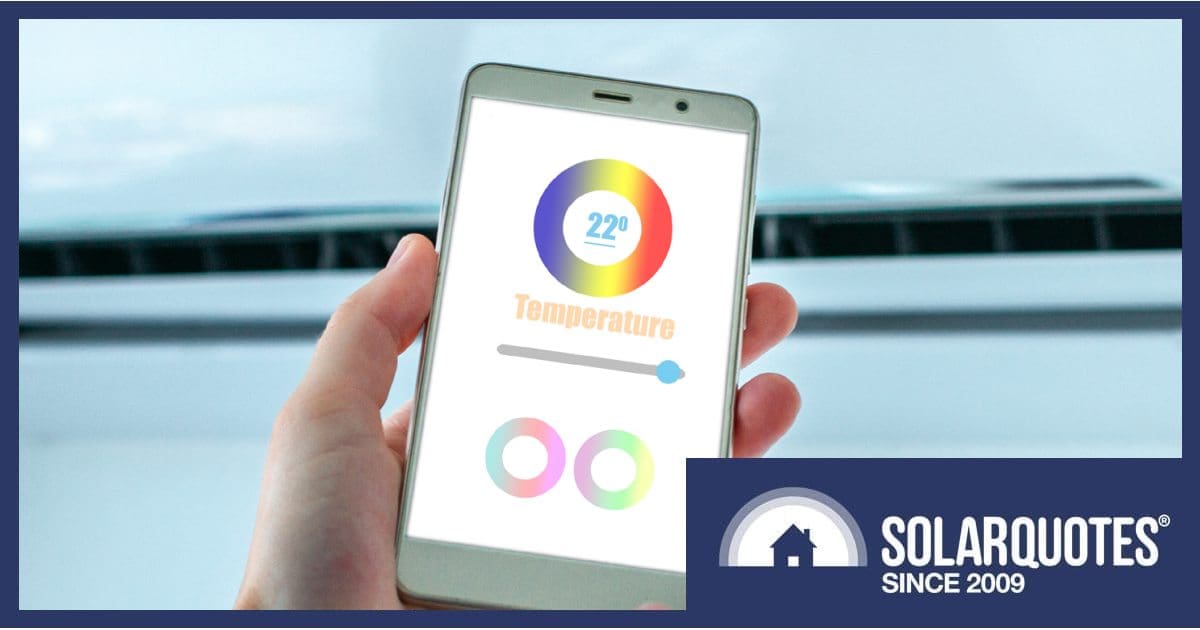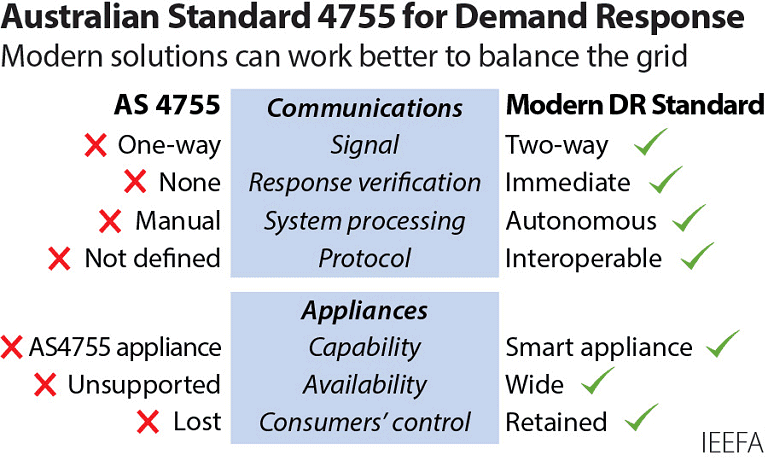
Air conditioners sold in Australia need to meet minimum efficiency standards, but not minimum “smarts”. This should change says a new report from IEEFA. Here’s why.
Heating and cooling represents around 40% of the energy use in the average Australian home. While improving thermal performance such as air-tightness of homes is critical to boosting energy efficiency, also important is more efficient air-conditioning. Using a reverse-cycle air conditioner (RCAC) is a good start as it’s the most energy-efficient space heater and cooler of all types commercially available.
There’s also an opportunity to make RCACs more grid and hip-pocket friendly through dynamic management. Some can have their energy use managed remotely or are ‘demand response enabled’. This (usually) means a third party such as a Distributed Network Service Provider or aggregator can control these air conditioners where necessary based on electricity network conditions.
There are already several air-conditioner related demand-response programs in Australia where customers receive financial or other rewards for participating. But a report released by the Institute for Energy Economics and Financial Analysis (IEEFA) this morning says governments need to do more to support participation and programs.
One of the ways to do this includes establishing standards to require RCACs in Australia to be smarter. An existing standard, AS4755, is a very basic, out-dated approach to demand response says IEEFA.
Around a quarter of a million households are already participating in voluntary retailer programs, but millions more aren’t. And with the transition to electrification, aircon related load on electricity networks will only climb.
“As increasing numbers of homes electrify their heating to reduce their energy bills and lower their emissions, ensuring that RCACs can be used as flexible demand will be an important way to help lower costs for consumers, improve the operation of the electricity grid, and reduce emissions,” says Dr Gabrielle Kuiper, author of the report.
And this isn’t just in regard to heating either, but cooling too as maximum grid demand usually occurs during the hotter months in most states. Very low grid demand is another beast that needs to be tamed as it can also threaten network stability. This usually occurs (and is occurring more often) when there are high levels of solar energy goodness in the grid. Air conditioners can help soak some of this up, but they need to be instructed when to do so.
Dr Kuiper says in most modeling, the potential demand flexibility capacity of reverse cycle air-conditioners is less than hot water or electric vehicles, but it still provides a significant opportunity.
Positive Customer Experience
While the thought of letting a third-party taking control of their home’s air-conditioner wouldn’t appeal to some, dynamic energy management of this nature done right also allows the customer to override it when required.
Many participants may not even notice when their aircon is being controlled if the RCAC fan is left running while switching off the compressor states Dr. Kuiper. A report some years ago concerning an Ausgrid trial stated 88% of respondents didn’t notice a difference in comfort during hot days when the power saving mode of units was activated.
Making Existing Air-Con Smart Is Cheap (But Subsidies Please)
The majority of new air conditioners available today have Wi-Fi control available as standard or optional; enabling their energy use to dynamically managed. But many existing “dumb” RCAC units can be managed remotely through the addition of smart thermostats.
“The technology required to make a new or existing RCAC smart is cheap,” says Dr. Kuiper. “And the development of platforms to reward demand flexibility is inexpensive compared to the costs of building new electricity generation and network infrastructure.”
Among its recommendations, the IEEFA says Australian governments should consider subsidising various add-on sensors and devices to make existing reverse-cycle air conditioning units smart. Furthermore, efficiency standards need to be raised, and aircon-related requirements also need to be put in place or rejiggered as soon as possible given the electrification shift and growing variable renewable energy supply, such as that from home solar power systems.
The report is available here: “Smart air conditioners could slash energy bills for consumers“.


 RSS - Posts
RSS - Posts



Pardon me if this is a little off topic…
I note that ‘heat pumps’ (compressors) are the most efficient way to raise or reduce temperatures of fluids in the home. I also note that in summer an all-electric household will have a hot water system discharging cold air at the same time as the nearby air-conditioner is discharging hot air.
Stage one of improving the efficiency of this arrangement may be to connect ducting between the two units so the HWS is pre-cooling the air into the AC. Or the other way around?
However I foresee a day when all heat pump equipment is linked by a refrigerant pipeline circumnavigating the central part of the house. If I use a ‘medium’ size residence – five bed / three bath – as my example this could reduce several split systems, two HWS and three fridges down to just one heat pump.
Has to be more energy efficient – although I’d want two heat pumps hooked up in tandem for redundancy.
Hi Clive,
I think you’ll find incorporating everything isn’t actually a simplification. Some refrigerants are more suitable for some jobs than others.
In fact the most efficient Vestfrost fridge I knew of (Sadly withdrawn from the market about 12 years ago) actually had two compressors and two refrigerants because the freezer had different run time & target temperature to the fridge. They just happened to be in the same box.
There may be some virtue to exchanges of air between units, but the amount of hot water you need versus the amount of air conditioning required would once again see radically different running times.
Thank you Anthony for your enlightening response.
I was aware of a variety of refrigerants but thought that was just evolution. I didn’t know they have different purposes.
I wasn’t suggesting a common compressor serving several appliances would be ‘simpler’. Just more efficient. In the same way switch-mode power supplies are way more complicated than iron core transformers. Or air conditioners for that matter are less reliable heaters than a 1,200w bar radiator 🙂
Now I’m predicting Heat Pump Wall Ovens. Yes you read it here first on SolarQuotes. I have no idea if suitable refrigerants for that sort of temperature exist yet but knowing our consumerist-driven economy I’m sure manufacturers would love an excuse to try and convince us that our current resistance element oven is “so yesterday”.
“As increasing numbers of homes electrify their heating to reduce their energy bills and lower their emissions, ensuring that RCACs can be used as flexible demand will be an important way to help lower costs for consumers, improve the operation of the electricity grid, and reduce emissions,” says Dr Gabrielle Kuiper, author of the report.”
Focussing on one aspect of home energy use is not so clever. What’s the point of requesting an RCAC be turned off for a while if at the same time you are charging up your two EVs, running your pool pump and running your HWS.
A much better system (although it requires a lot more smarts) is to ask the house to reduce its power consumption, and let the house decide what can be reduced (based on owner preferences).
Although I’m a fan of technical innovation, this proposal by IEEFA seems not only somewhat ‘Big Brotherish”, but also of short term marginal economic benefit, plus their likely high initial cost.
Rapidly increasing temperature extremes are already causing growing numbers of people to migrate to other geographic locations.
With a bit of commonsense a reverse-cycle air conditioner with a remote temperature control can be quite effective, and using low-cost fans to circulate air to other areas can be easily done.
Many people can’t even afford to pay their basic electricity bills at present, let alone find the money needed to both purchase and then install an existing model air-conditioner, let alone an allegedly ‘smart’ one.
.
Hi Des,
I think the bigger question is why we don’t build better house in the first place, ones that don’t need so much air conditioning. The “pink batts scheme” was a great start but sadly it was politicised to death, despite actually being a marked success on basically every metric.
Well… I knew some people whose pink batts were saturated with water during an extreme weather event, due to penetration into the interior roof space. The added weight caused the batts to break through their plaster-board ceiling, ruining many of their possessions.
So I’m no fan of pink batts I’m afraid.
They can work quite well initially though, and possibly the newer varieties which have a rated life span of 50 – 70 years could be worthwhile.
.
Sorry to read of your friends who suffered a ceiling collapse due to water-logged ceiling insulation. However I suspect that even without the batts the weight of the water pooling on top of the plasteboard would still have brought it down.
Good celing insulation is certainly a significant way to reduce heat gain and loss in almost any house, thereby saving on air conditioning use.
Great insights on smart air conditioning solutions.
Speaking of efficiency, another excellent way to cut energy costs and improve sustainability is through industrial LED lighting upgrades. For businesses in Victoria and SA, upgrading to LED lighting can significantly reduce power consumption, lower maintenance costs, and enhance workplace visibility. There are subsidy schemes to defray the costs.
Combining smart HVAC with efficient lighting can make a difference in energy savings!